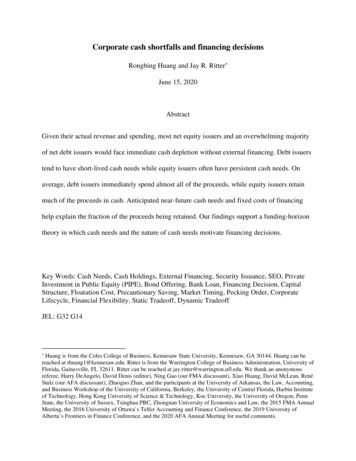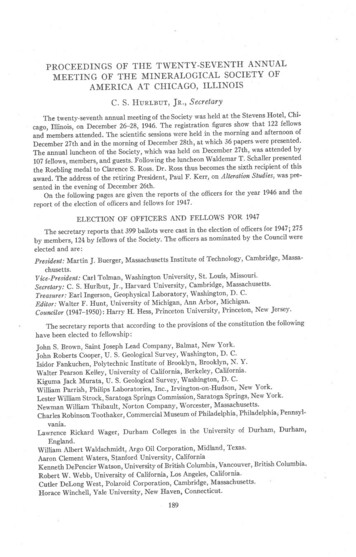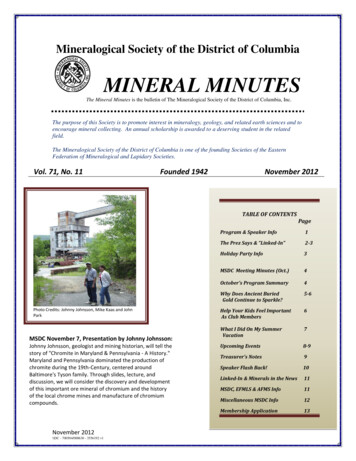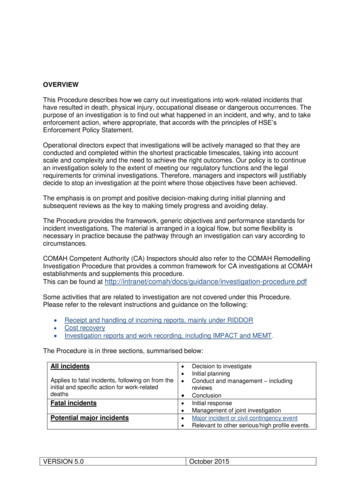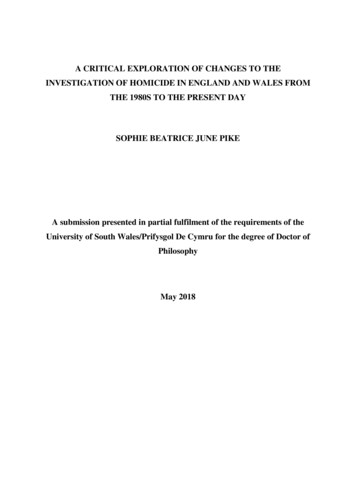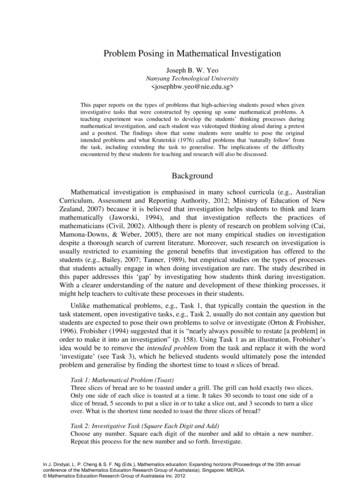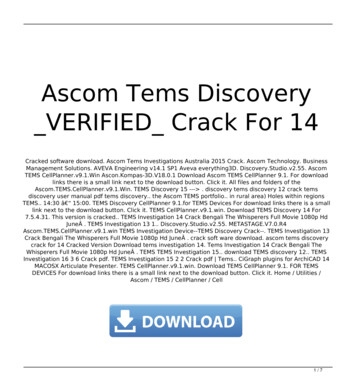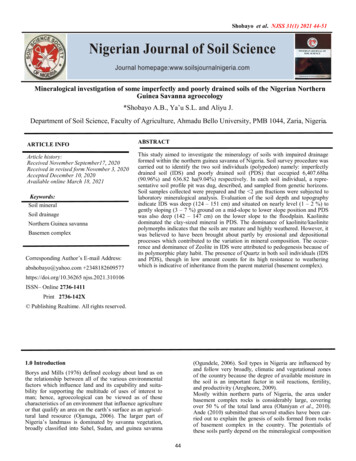
Transcription
Shobayo et al. NJSS 31(1) 2021 44-51Mineralogical investigation of some imperfectly and poorly drained soils of the Nigerian NorthernGuinea Savanna agroecology*Shobayo A.B., Ya’u S.L. and Aliyu J.Department of Soil Science, Faculty of Agriculture, Ahmadu Bello University, PMB 1044, Zaria, Nigeria.ARTICLE INFOABSTRACTArticle history:Received November September17, 2020Received in revised form November 3, 2020Accepted December 10, 2020Available online March 18, 2021This study aimed to investigate the mineralogy of soils with impaired drainageformed within the northern guinea savanna of Nigeria. Soil survey procedure wascarried out to identify the two soil individuals (polypedon) namely: imperfectlydrained soil (IDS) and poorly drained soil (PDS) that occupied 6,407.68ha(90.96%) and 636.82 ha(9.04%) respectively. In each soil individual, a representative soil profile pit was dug, described, and sampled from genetic horizons.Soil samples collected were prepared and the 2 μm fractions were subjected tolaboratory mineralogical analysis. Evaluation of the soil depth and topographyindicate IDS was deep (124 – 151 cm) and situated on nearly level (1 – 2 %) togently sloping (3 – 7 %) ground on a mid-slope to lower slope position and PDSwas also deep (142 – 147 cm) on the lower slope to the floodplain. Kaolinitedominated the clay-sized mineral in PDS. The dominance of kaolinite/kaolinitepolymorphs indicates that the soils are mature and highly weathered. However, itwas believed to have been brought about partly by erosional and depositionalprocesses which contributed to the variation in mineral composition. The occurrence and dominance of Zeolite in IDS were attributed to pedogenesis because ofits polymorphic platy habit. The presence of Quartz in both soil individuals (IDSand PDS), though in low amount counts for its high resistance to weatheringwhich is indicative of inheritance from the parent material (basement complex).Keywords:Soil mineralSoil drainageNorthern Guinea savannaBasemen complexCorresponding Author’s E-mail Address:abshobayo@yahoo.com 2348182609577https://doi.org/10.36265 njss.2021.310106ISSN– Online 2736-1411Print 2736-142X Publishing Realtime. All rights reserved.1.0 Introduction(Ogundele, 2006). Soil types in Nigeria are influenced byand follow very broadly, climatic and vegetational zonesof the country because the degree of available moisture inthe soil is an important factor in soil reactions, fertility,and productivity (Aregheore, 2009).Mostly within northern parts of Nigeria, the area underbasement complex rocks is considerably large, coveringover 50 % of the total land area (Olaniyan et al., 2010).Ande (2010) submitted that several studies have been carried out to explain the genesis of soils formed from rocksof basement complex in the country. The potentials ofthese soils partly depend on the mineralogical compositionBorys and Mills (1976) defined ecology about land as onthe relationship between all of the various environmentalfactors which influence land and its capability and suitability for supporting the multitude of uses of interest toman; hence, agroecological can be viewed as of thosecharacteristics of an environment that influence agricultureor that qualify an area on the earth’s surface as an agricultural land resource (Ojanuga, 2006). The larger part ofNigeria’s landmass is dominated by savanna vegetation,broadly classified into Sahel, Sudan, and guinea savanna44
Mineralogical investigation of some imperfectly and poorly drained soils of the Nigerian Northern Guinea Savanna agroecologyof the Basement complex. Identifying these minerals is astep to understanding the soil properties. The soil particlesof which the clay fraction contains more mineral materialshave a great influence on the development of soil physicaland chemical properties. In most soil, properties of waterretention, hydraulic conductivity, swelling and shrinking,and cation exchange are largely controlled by mineralogical composition. Identification and characterization of clayminerals are one of the basic requirements for classifyingsoils as well as for the better understanding of soil genesis(Islam and Husain, 2008). Among commonly used methods to accomplish mineralogical analysis is X-ray difraction (XRD), which has proven to be indispensable (Denget al., 2009).Soil drainage evaluation of the study area identified thesoils to be predominantly of imperfect drainage (IDS) anda contiguous land tract downslope adjoining the streamsand river to be poorly drained (PDS). The soil drainage isassociated with the water table level that defines the moisture regimes as udic and aquic (Soil Survey Staff, 2014).The moisture regimes have partly been used together withthe soil mineralogy to classify the soils as UlticHaplustalfsfine-loamy, mixed, subactive, iso hyperthermic, and AericEndoaqualfs coarse-silty, mixed, active, iso hyperthermicrespectively for IDS and PDS (Shobayo, 2019). This isbecause they affect soil genesis (formation), affect the useand management of soils, and can be used to group soilswith similar properties and morphology. The soils understudy have sufficient moisture for crops; however, management considerations vary. The latter (PDS) may needartificial drainage for some cropping practices. Moisturelevels of the soils have influenced the soil color as it darkens the soils by increasing light absorption. Improperlydrained soils may give a grayish matrix because iron oxides occur in the ferrous state (Jackson, 2014) while soilswith blackish color may be attributed to staining by manganese oxides when organic material is lacking.Comprehensive knowledge of soil mineralogy in Africa islacking due to poorly and fragmentally coordinated scientific investigations coupled with the limitations in the traditional analytical techniques (Kamau, 2013). Therefore,the study was conducted to characterize the mineralogicalcomposition of the less than 2 μm fraction within a soilprofile of the selected drainage impaired soils.2.0 Materials and methods2.1 Location of the sampling siteThe study area lies on latitude 11º25'N to 11º34'N and lon-Figure 2:Rainfall data of study areaFigure 3:Temperature data of study areaFigure 1: Location map of the study area45
Shobayo et al. NJSS 31(1) 2021 44-51greater than 2 mm (gravel). The clay mineralogical analysis of the less than 2 mm soil particles was carried out.2.4 Mineralogical analysisThe samples were prepared by first removing exchangeable cations, organic matter, and sesquioxides from thesamples following the method described by Kunze andDixon (1986). Particle size separation was determined bythe method described by Gee and Or (2002). The gravelcontent was first removed by direct sieving. Sand, silt, andclay were determined by Bouyoucos hydrometer method,using sodium hexametaphosphate as a dispersant and determining sizes and amount of particles settling by employing progressive time intervals. After obtaining the claysamples, preparation for an oriented mount for presentation to x-rays continued. About 5 - 10 g of clay samplewas put into a clean test tube with the aid of a spatula.Distilled water was added to dissolve the sample and subsequently placed inside the centrifuge machine. This wasallowed to run at 5 rpm for 5 minutes after which it wasremoved and the floating material was decanted. Anotherdistilled water was added, mixed thoroughly, and againplaced inside the centrifuge machine and ran the secondtime. This process went on five times to be sure individualsamples went into a clear suspension. After decanting severally, about 3 - 5 drops ofwere added. At this point, a clear suspension of clay was formed above, while the unwanted settledat the bottom of the test tube. A dropper was used to takesome quantity of the suspended clay, saturated with magnesium ions, and was applied on a clean labeled glassslide. This was allowed to dry overnight in an oven at 105 C and ready foranalysis. The x-ray diffraction(XRD) analysis of the clay fraction was done at the Department of Physics, Umaru Musa Yaradua University,Katsina State, Nigeria.gitude 7º16'E to 7º22'E, located in Funtua, Funtua LocalGovernment Area (LGA) of Katsina State, Nigeria. It isbordered by Faskari LGA to the north, Bakori and DanjaLGAs to the east, and Dandume LGA to the west (Fig. 1).2.2 ClimateThe climate of the study area is typical of that of the northern guinea savanna of Nigeria. It is characterized by a longdry season and a shorter but very conspicuous wet season.It has total annual rainfall figures ranging from 800 mm toover 1000 mm. The mean monthly maximum range oftemperature was between 28.70 and 35.40 C; while theminimum range between 16.89 C and 32.70 C (Abaje etal., 2016). Figures 2 and 3 show the rainfall and temperature data of the study area.The area has a land coverage of 7,044.5 ha.2.3 Method of sample collectionA reconnaissance soil survey was carried out in the studyarea. This was undertaken to obtain preliminary information as well as the actual land area that was studied(7,044.5 ha); thus, the study enabled for detailed soil survey (Soil Science Division Staff, 2017). The conventionalmethod of a survey involving GPS assisted procedure wasadopted and the soil survey work identified two soil individuals (namely: IDS and PDS). The concept of the soilindividual was based on soils that shared similar morphological, topographical, and physical characteristics ofdepth, drainage, the colour of soil matrix and mottles, texture, and structure identified. In each soil individual thatwas identified, one soil profile pit was dug, described, andsampled from the bottom-up, to minimize contaminationby falling debris across a horizon’s full depth and breadthaccording to the occurrence of the genetic (natural) horizon for soil mineralogical characterization. The soil samples were air-dried in the laboratory, crushed with porcelain pestle and mortar, and sieved to remove materialsHorizonDepthAp(cm)0-22XRD Diffractograms of clay samplesFigure 4: X-ray diffractograms of clay-sized particle of IDS 0-22 cm46
Mineralogical investigation of some imperfectly and poorly drained soils of the Nigerian Northern Guinea Savanna agroecology3.0 Results and Discusion5.6090 Å, 3.0600 Å, 5.0180 Å), clinochrysotile (7.3500 Å,3.6600 Å, 4.5400 Å, 2.4600 Å, 1.5370), and mcgillite(2.5600 Å, 7.1600 Å, 2.8880 Å, 3.5700 Å, 2.1120 Å). Thepredominance of clinochrysotile (a member of polytypesof chrysotile), a soft, fibrous silicate mineral in the serpentine subgroup of phyllosilicates indicates that the surfacesoils could be easily tilled because of their considerabletensile strength. Its high resistance to weathering had resulted in a low release of Mg to the soils and contributedto the soils’ CEC. However, the selectively dissolved MgThe mineralogy of clay fractions of the soils is discussedbelow and their various diffractograms are shown in Figures 4 - 9. Table 1 shows the summary of the mineralogical characteristics of the soil individuals.X-ray diffractogram of clay fraction revealed three majorminerals in surface soils (0 - 22 cm) of soil individual IDSas shown in Fig. 4. The major minerals as confirmed bythe various peaks are scorodite (4.4720 Å, 3.1780 Å,HorizonBgDepth (cm)22-60XRD Diffractograms of clay samplesFigure 5: X-ray diffractograms of clay-sized particle of IDS 22-60 cmion might have contributed to the soils’ incipient acidity.Scorodite, on the other hand, is an iron arsenate mineralcommonly associated with arsenic-bearing ore deposits as aweathering product. It is metastable under most conditionsand tends to dissolve incongruently, forming iron hydroxides and releasing arsenate to a solution (Dove and Rimstidt,1985). The varying hydroxides of iron formed had contributed to its brownish red to yellowish-brown coloration, itsHorizonBtgDepth60-109 cmoccurrence is suggested to be neoformed from the basementcomplex weathering. The occurrence of mcgillite in this soilunit appears to be largely inherited from the parent materialrather than of pedological significance but may be quite susceptible to decomposition if the environment becomes veryunstable (i.e. intensive leaching) as has been reported toform as fracture fillings in a manganese-rich portionof quartzite, a major make up of the basement complex.XRD Diffractograms of clay samplesFigure 6 X-ray diffractograms of clay-sized particle of IDS 60-109 cmAt the subsurface soils (22-60 cm), quartz (3.3430 Å, 4.2545Å, 1.8176 Å, 2.4564 Å, 2.2810 Å, 1.5413 Å), kaolinite(3.5809 Å, 7.1697 Å, 2.3867 Å, 2.3409 Å, 2.2951 Å) andzeolite-ferrierite (9.5216 Å, 3.5296 Å, 3.4634 Å, 3.9796 Å,3.7665 Å) dominated. Quartz is primarily of igneous rocks, itis resistant enough to weathering which counts for its presence in low amount; however, it is indicative of inheritancefrom the parent material and might be the product of neotransformation. The dominance of kaolinite is an indicationthat the soil had weathered considerably however they may47
Shobayo et al. NJSS 31(1) 2021 44-51not have been formed in-situ but brought about by erosional and depositional processes. Ferrierite on the other handis a species of zeolite that may have also contributed to theNa level of the soil.At the lower subsurface soil depth (60-109 cm), zeolitechabazite (4.7000 Å, 5.4700 Å, 9.2300 Å, 2.8900 Å,3.5700), Sialon (3.3420 Å, 2.7410 Å, 2.5250 Å, 2.2340 Å,HorizonDepth (cm)Ap0-171.7890 Å, 1.3110 Å) and kaolinite-mullite (4.3626 Å,6.8594 Å, 3.4297 Å, 4.0906 Å, 4.1396 Å, 3.7964 Å) dominated. The occurrence of zeolite-chabazite in this soilmight be as veins in the clay mineral composition anddominance of zeolite in the clay fractions was attributed topedogenesis because of its polymorphic platy habit. Sialondetected having complex chemistry presupposes they wereXRD Diffractograms of clay sampleFig. 7 X-ray diffractograms of clay-sized particle of PDS 0-17 cmcommonly associated with alluvial deposits containing theresistant weathered grains of igneous rock.At the subsurface soils (17 – 40 cm), amphibole (7.6300 Å,3.5020 Å, 3.8100 Å, 1.4840 Å, 2.5360 Å) and kaolinite(7.1538 Å, 3.5769 Å, 4.3612 Å, 4.1809 Å, 3.8430 Å, 4.1289Å) dominated. Amphibole found in this soil is an indicationof the soil unit being less tensely weathered, however thepresence of kaolinite in appreciable abundance implies thesoil had been subjected to a high degree of weathering. Thepresence of amphibole may have also contributed to the enrichment of calcium in the soil being the most abundantamong the exchangeable bases. Yagodin (1984) observedthat the exchange capacity decreases with an abundance ofkaolinite in the inorganic portion of the soil and when thenot inherited from the parent material and might be the product of neo-transformation. The abundance of kaolinite indicates that an extensive pedogenic process has occurred andhas contributed to the moderate and low cation exchangecapacity of the soils.X-ray diffractogram of clay fraction revealed two majorminerals in surface soils (0 - 17 cm) of soil individual PDSas shown in Fig. 8. The minerals contained in PDS as confirmed by the various peaks against corresponding 2ThetaBraggs angle were: cassiterite – SnO2 (3.3468 Å, 2.6404 Å,1.7623 Å, 2.3666 Å, 1.4135 Å, 1.6734 Å), and kaolinite(7.1700 Å, 1.6200 Å, 1.4890 Å, 3.5790 Å, 4.3660 Å, 1.5860Å). Cassiterite imparted on the surface soil the characteristicbrownish color (Dark yellowish brown -10YR4/6) and isHorizonBg1Depth17-40 cmXRD Diffractograms of clay sampleFig. 8 X-ray diffractograms of clay-sized particle of PDS 17-40 cm48
Mineralogical investigation of some imperfectly and poorly drained soils of the Nigerian Northern Guinea Savanna agroecologyfine fraction contains great amounts of amorphous ferricand aluminum hydroxides.At the lower subsurface soil depth (40 - 142 cm), sericite(4.5000 Å, 4.4100 Å, 13.8000 Å, 4.3300 Å, 4.0000 Å),greenalite (2.5700 Å, 7.1200 Å, 3.5600 Å, 1.5900 Å,2.1800 Å, 1.5500 Å) and magnetite-high (2.5406 Å,1.4895 Å, 2.9790 Å, 1.6216 Å, 2.1065 Å, 4.8648 Å) dominated with low quartz (3.3430 Å, 4.2545 Å, 1.8176 Å,HorizonDepthBg240-142 cm2.4564 Å, 2.2810 Å, 1.5413 Å). Sericite, a fine-grainedmica contributed significantly to the soil’s CEC. Its presence in the subsurface soils provides useful information onthe geochemical origin of the soil parent material and thestage of weathering. It has also contributed to the K levelof the soil. However, sericite is resistant enough to weathering which counts for its presence in a low amount. Sincesome mica are known to persist in the clay fraction even inXRD Diffractograms of clay sampleFig. 9 X-ray diffractograms of clay-sized particle of PDS 40-142 cmhighly weathered soils, this probably accounts for the smallamount of K found in this soil.Greenalite on the other hand is a species of the kaolinite thatmay have been inherited from the acid sediments fromwhich the soil may have been formed. The low presence ofquartz in this soil was attributed to its tolerance to weathering. Magnetite was abundant in this soil individual whichcontributed to its characteristic black color (black - 5Y2.5/2)at the subsurface horizons; and its formation might be attributed to the fluctuating water table. Ahmeda and Maherb(2018) linked reduction of iron to form Fe2 - bearing magnetite to soil wetting/drying. Santana et al., (2001) opinedthat it is not clear if the pedogenic stability of lithogenicmagnetite is related to the nature of the parent material.However, they submitted that factors affecting its formationfrom the parent material or through pedogenesis determineits fate through soil mineral genesis pathways; such as redoxpotential, pH and ions (e.g. Fe3 ), organic matter, and wateravailability. This implies that either in situ formation of soil-derived magnetite can occur but the latter may contributeto the natural remanent of the former.4.0 ConclusionThe mineralogical characteristics of the soil individuals(IDS and PDS) as shown by the analysis carried out indicate that the soils were not ultimately a product of erosional and depositional processes considering the drainage and topographic positions of the soils (midslope –lower slope-floodplain) but to a larger extent developedfrom the parent material (Basement Complex rocks).The occurrence of quartz and zeolites even at the subsoils was attributed to inheritance from the parent material implying that the soils could have been formedlargely in-situ. One could also infer given the mineralcharacteristics that eroded and decomposed minerals arebasically from the adjacent land of the same parent material. The predominance of kaolinite (greenalite) in IDSand PDS with their depth characteristics implies the soilsare highly weathered.49
PDSMAPUNITIDS50100, 22, 10, 6, 6, 6100, 79, 14, 2, 2100, 79, 63, 50, 40100, 72, 57, 54, 38100, 100, 100, 90, 90, 903.3430Å, 4.2545Å, 1.8176Å, 2.4564Å, 2.2810Å,1.5413Å3.5809Å, 7.1697Å, 2.3867Å, 2.3409Å, 2.2951Å9.5216Å, 3.5296Å, 3.4634Å, 3.9796Å, 3.7665Å4.7000Å, 5.4700Å, 9.2300Å, 2.8900Å, 3.5700Å3.3420Å, 2.7410Å, 2.5250Å, 2.2340Å, 1.7890Å,1.3110Å4.3626Å, 6.8594Å, 3.4297Å, 4.0906Å, 4.1396Å,3.7964Å3.3468Å, 2.6404Å, 1.7623Å, 2.3666Å, 1.4135Å,1.6734Å7.1700Å, 1.6200Å, 1.4890Å, 3.5790Å, 4.3660Å,1.5860Å7.6300Å, 3.5020Å, 3.8100Å, 1.4840Å, 2.5360Å7.1538Å, 3.5769Å, 4.3612Å, 4.1809Å, 3.8430Å,4.1289Å4.5000Å, 4.4100Å, 13.8000Å 4.3300Å, 4.0000Å2.5700Å, 7.1200Å, 3.5600Å, 1.5900Å, 2.1800Å,1.5500Å2.5406Å, 1.4895Å, 2.9790Å, 1.6216Å, 2.1065Å,4.8648Å3.3430Å, 4.2545Å, 1.8176Å, 2.4564Å, 2.2810Å,1.5413Å26.64, 20.86, 50.14, 36.55, 39.47, 59.969.28, 25.21, 25.70, 22.32, 23.6020.78, 16.19, 9.57, 30.91, 24.9226.65, 32.64, 35.52, 40.33, 51.00, 71.9612.36, 24.87, 20.34, 21.23, 23.12, 21.5034.88, 12.42, 24.99, 57.95, 41.38, 59.59Sub Subsurface SoilSubsurfaceSoilSurface SoilSub Subsurface Soil26.64, 20.86, 50.14, 36.55, 39.47, 59.9635.29, 62.27, 29.96, 56.72, 42.89,18.2219.71, 20.11, 6.39, 20.49, 22.2011.58, 25.41, 23.32, 62.53, 35.3612.33, 56.78, 62.30, 24.85,20.32, 58.1126.61, 33.92, 51.83, 37.99, 66.04, 54.8120.33, 12.89, 25.95, 21.70, 21.44, 23.41100, 22, 10, 6, 6, 6100, 34, 29, 26, 20,10100, 80, 80, 60, 40, 40100, 40, 30, 30, 25100, 52, 50, 47, 32, 23100, 47, 20, 20, 17100, 70, 90, 80, 60, 60100, 75, 53, 21, 14, 12100, 82, 50, 45, 31, 26100, 70, 60, 40, 402.5600Å, 7.1600Å, 2.8880Å, 3.5700Å, 2.1120Å35.02, 12.35, 30.93, 24.92, 42.7824.84, 12.33, 37.65, 38.42, 39.22100, 70, 15, 15, 127.3500Å, 3.6600Å, 4.5400Å, 2.4600Å, 1.5370 Å12.03, 24.29, 19.53, 36.49, 60.15SubsurfaceSoil100, 90, 80, 45, 354.4720Å, 3.1780Å, 5.6090Å, 3.0600Å, 5.0180ÅINTENSITY19.83, 28.05, 15.78, 29.15, 17.66)Surface SoilD(2θHORIZONTable 1: Summary of soil mineralogical characteristics of the study rtzMcgilliteClinochrysotileScoroditeMINERALShobayo et al. NJSS 31(1) 2021 44-51
Mineralogical investigation of some imperfectly and poorly drained soils of the Nigerian Northern Guinea Savanna agroecologyReferenceKenyatta University.Katsina Diary (1989). The Diary of Katsina State, Nigeria.Government Printers, Katsina.Kunze, G.W. and Dixon, J.B. (1986). Pretreatment and Mineralogical analysis. In: Klute (eds). Methods of soilanalysis, Part 1: Physical and Mineralogical Methods.2nd Ed. ASA, SSSA. Madison, WI. 91-100p.Maniyunda, L.M. (2012). Pedogenesis of a lithosequence inthe northern guinea savanna of Kaduna State, Nigeria.Unpublished Ph. D Thesis. Dept. of Soil Science, ABU,Zaria.McCurry, P. (1976). The geology of the Precambrian tolower Paleozoic rocks of Northern Nigeria – A review.In: Kogbe, C. A. (ed.). Geology of Nigeria. ElizabethanPublishing Company, Lagos. pp 15- 40.Moormann, F.R., Lal, R. and Juo, A.S.R. (1975). The soilsof IITA. International Institute for Tropical Agriculture.Technical Bulletin 2: 43pp.Muggler, C.C., Buurman, P. and van Doesburg, J.D.J.(2007). Weathering trends and parent material characteristics of polygenetic Oxisols from Minas Gerais,Brazil:1.Mineralogy. Geoderma138 (1-2):39-48.Niranjane, S.J., Gaikawad, S.T., Gajbhiye, K.S. andThayalan, S. (2005).Clay minerals composition in somesoils of the eastern part of Maharashtra. Clay Research24 (2).Ojanuga, A.G. (1975). Morphological, physical, andchemical characteristics of soils of Ife and Ondo areas.Nigeria Journal of Soil Science, 9:225-269.Olaniyan, I.O., Agunwamba, J.C. and Ademiluyi, J.O.(2010). Lithologic characteristics of parts of the crystalline basement complex of northern Nigeria in relationto groundwater exploitation. ARPN Journal of Engineering and Applied Sciences. Vol. 5 (7): 56 - 60.Santana, G.P., Fabris, J.D., Goulart, A.T. and Santana, D.P.(2001). Magnetite and its transformation to hematite ina soil derived from steatite. R. Bras. Ci. Solo, 25:3342.Shobayo A.B. (2019). Taxonomic and Land CapabilityClassifications of Some Nigerian Northern Guinea Savanna Soils. Journal of Crop Research, A groforestryand Environment 3:83-103.Soil Science Division Staff (2017). Soil survey manual. C.Ditzler, K. Scheffe, and H.C. Monger (eds.). USDAHandbook 18. Government Printing Office, Washington, D.C.Velde, B. (1985). Clay Minerals: A Physico-chemical explanation of their occurrence.Elsevier, Amsterdam.pp. 38-43.Yagodin, B.A. (1984). Agricultural Chemistry. First editionMir publishers Moscow. Pp152-193.Abaje, I. B., Abdullahi, N. and Jeje, O.G. (2016). Climatechange and infectious diseases in Funtua Local Government Area of Katsina State, Nigeria. International Journal of Science and Technology (STECH), 5(1): 47-58.Ahmeda, I.A.M., and Maherb, B.A. (2018). Identificationand paleoclimatic significance ofmagnetite nanoparticles in soils. Proceedings of the National Academyof Sciences, Feb. 2018.Accessed online @https://doi.org/10.1073/pnas.1719186115Brady, N.C., and Weil, R.C. (2013). The nature and properties of soils. 14th edition, published by Pearson Education, Inc. publishing as Prentice Hall, copyright 2008,second impression 2013, pp 53, 840-872.Brookins, D.G. (1988). Eh-pH Diagrams for Geochemistry.Springer-Verlag, Berlin,288p.Deng, Y., White, G.N. and Dixon, J.B. (2009). Soil mineralogy laboratory manual. 11th edition. Published by theauthors, Department of Soil and Crop Sciences, TexasA&M University, College Station, Texas 77843-2474.Dove, P.M. and Rimstidt, J.D. (1985). The solubility andstability of scorodite, FeAsO4.2H2O. A merican Mineralogist, Vol. 70, pp. 838-844.Esu, I.E. (1987). Fertility status and management of someupland basement complex soils in the Nigeria tropicalsavanna region. Nigerian Journal of Soil Science. 7: 155-183.Gee, G.W. and Or, D. (2002). Particle size analysis. In:Dane, J.H. and Topp, G.C. (eds).Methods of soilanalysis, part 4. Physical methods. Soil Science Societyof America. Book series.No. 5 America SocietyAgronomy and Soil Science Society of America Madison, W1, pp 255-293.Gold, C. M., Cavell, P. A., and Smith, D. G.W. (1983) Clayminerals in mixtures: Sample preparation, analysis, andstatistical interpretation: Clays and Clay Minerals, 31:191-199.Hseu, Z.Y., Tsai, H., Hsi, H.C. and Chen, Y.C. (2007).Weathering sequences of clay minerals in soils along aserpentinitic toposequence. Clays and Clay Minerals,55:389-401.Kamau, M.N. (2013). Characterization of soil mineralogy inrelation to soil fertility functional properties for selectedcountries in Africa. Unpublished M.Sc. Thesis, Department ofAgriculturalResourceManagement,School of Agriculture and Enterprise Development,51
Department of Soil Science, Faculty of Agriculture, Ahmadu Bello University, PMB 1044, Zaria, Nigeria. 1.0 Introduction Borys and Mills (1976) defined ecology about land as on the relationship between all of the various environmental factors which influence land and its capability and suita-bility for supporting the multitude of uses of interest to

